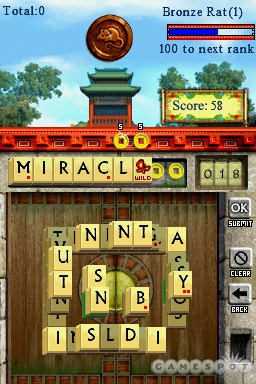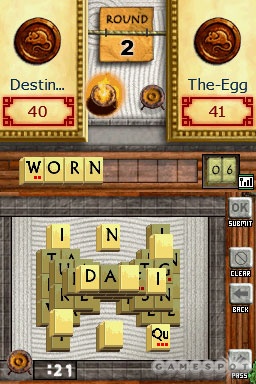Considering that you can play WordJong for free at various Web sites, or for just a few bucks on your cell phone, the Nintendo DS rendition of it had better offer something beyond portability to justify the $20 price tag. The good news is, it does. In addition to packaging two of the most popular variations of this addictive brain teaser together on a single cartridge, Destineer and Magellan Interactive have also included a battle mode that lets you test your word-making skills against live opponents using Nintendo's Wi-Fi Connect service.
If you're not already familiar with WordJong, the concept is easy enough to grasp: It's basically mahjong meets Scrabble. You're given a mountain of tiles and, starting at the top, you have to clear away the mountain a few tiles at a time. However, instead of lifting away matching pairs of tiles, you lift away tiles by forming words out of the letters printed on them. For example, if you picked up the tiles to spell "CHIMP," they'd be removed from the pile. You can't grab tiles that are boxed in or buried by other tiles, so there's some challenge involved in making words out of what you're given to work with.

One of the reasons that WordJong is so addictive is that it employs a scoring system that rewards you for stringing together complicated or lengthy words. The letter tiles are assigned point values, just like the tiles in Scrabble, and you get bonuses for words that contain uncommon letters like Z, V, or the "Qu" combination. You also earn extra points when a word is between six and nine letters (the maximum length). So, the question is, do you play it safe and go for easy four-letter words, or do you go for the big points and risk being unable to complete the puzzle because you ran out of vowels?
Over the years, WordJong has evolved into two distinct variations for Web and cellphone platforms. The Nintendo DS cartridge includes both of them. From the Web comes the daily puzzle mode, which incorporates wild tiles into the pile and rewards you with a bomb whenever you produce a word that's at least five letters long. The calendar-style menu gives you more than 700 different puzzle layouts to pick from, and each puzzle has a predefined top score that you're supposed to beat. Meanwhile, the cell phone platform's contribution is the temple challenge mode. The piles are larger and randomly generated, there are no bombs, and the wild tiles have been replaced by green multiplier tiles that really cause scores to skyrocket. Unlike the daily mode, which is just a bunch of one-offs, the temple challenge mode keeps giving you newer and tougher piles as you grow in rank, and it records your cumulative progress.
WordJong DS also includes a one-on-one battle mode that lets you match wits and scores against the CPU or other living, breathing players. In this mode, there's just one shared pile and the players alternate turns forming words. The winner is the player with the highest score after two rounds. Unlike the other modes, there are no wild tiles, bombs, or score multipliers in the battle mode. You also can't see or even touch the tiles sitting beneath the ones you pick up, which means it's tougher to form large words in battle matches compared to the relative ease by which you can do so in the other noncompetitive modes. You'd think those simplifications would hurt gameplay, but in reality they don't, because all that streamlining makes matches play out fast and furiously.
You can play the battle mode with your friends locally or with people online. For local play, you can pass around a single system or use the DS download feature to link two systems together using just the one cartridge. Lag isn't a problem with online matches, since players alternate turns. However, unless you hit up your buddies and favorite message boards to exchange friend codes, you're going to have a difficult time finding people to compete against online. As of the writing of this review, it seemed there was hardly enough people logged in for random matchmaking to be fruitful.

Bear in mind, too, that you won't be blown away by the presentation. The frog pond and temple backdrops are static apart from the occasional water droplet. All of the letter tiles are basically just Scrabble pieces, and the only action you'll ever witness is when the letters fly off the screen. At least the letter tiles are easy to read, and the Asian-themed music is pleasant without ever becoming a distraction.
As for the miscellaneous aspects, the game's dictionary recognizes some pretty obscure words, while the touch-screen controls make it easy to pick letters and tap the undo button. Selecting letters by tapping them is much easier than using cell phone keys. The DS game also doesn't suffer from the input lag that many of the cell phone versions do. Another feature exclusive to the DS rendition is the inclusion of an awards tracker, which gives you butterfly medals for achieving various milestones (spell a word worth 100 points, spell a nine-letter word, and so on). It won't be a big deal for most people, but it's a nice motivational feature nonetheless.
All in all, if you're a vocabulary snob and proud of it, you'll probably enjoy WordJong for the Nintendo DS. The basic premise is highly addictive, each mode offers a different take on the concept, and the battle mode offers the competitive edge that previous incarnations were missing.